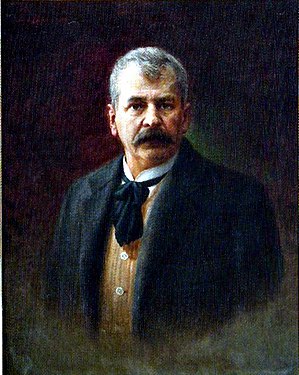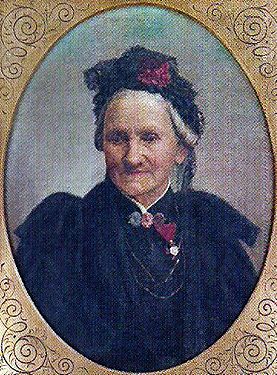Ferdinand Behrens

Ferdinand Christian Conrad Behrens (born March 11, 1862 in Lübeck , † February 4, 1925 in Meran ) was a portrait painter and art dealer and as such also a promoter and agent of fellow artists.
Life
Ferdinand Behrens was born the son of the tailor Johann Casper Heinrich Behrens. He died on February 5, 1875.
He concluded his school days with confirmation on April 9, 1876, Palm Sunday , by the archdeacon in the Petrikirche in Lübeck . After Easter he began his apprenticeship as a painter with Carl Bock . Those who came from the simplest of backgrounds were released to attend the trade school .
On March 12, 1878, his mother married the painter Carl Stave (1838-1892), widowed since 1877 . For them it meant not only a better financial position and security, but also a social upgrade. The marriage was divorced on March 29, 1881 by the Lübeck district court .
After showing a very good sample, Ferdinand Behrens was “acquitted” of his apprenticeship in March 1880. It was exhibited in the "Lübeck industrial hall", which was located in the castle, during the Easter holidays. On April 4th he received a first class diploma with the grade “very good”. As an award he received a splendidly executed honorary diploma.
In 1882 Ferdinand Behrens had to be drafted . Since the registrations and de-registrations of residences in Lübeck were recorded from 1884, he must have left the city beforehand.
In 1880 he went to the Hanover School of Applied Arts for further studies , then to the Dresden School of Applied Arts and finally to the “Zeichen- u. Painting school based on the Munich pattern for men a. Ladies ”in Vienna . The Strehblow school of painting was not only considered the most important painting school in Vienna from 1900.
In 1889 he moved to Merano, where he worked as a portrait painter. He mainly painted his portraits from photographs.
In the summer of 1893 Behrens was commissioned to copy six portraits that were in private hands at the time. They were participants in the Battle of Bergisel . In the Tyrolean Kaiserjägermuseum , which opened in 1880, an Andreas Hofer monument was to be unveiled and a hero gallery of the same name was to be opened. The portraits were intended for them.
In the 1890s he created pictures of Karl Ludwig von Austria , Alfred zu Salm-Reifferscheidt-Dyck and his wife Marie-Dorothea Countess von Bellegarde and Emma Hellenstainer . The latter was exhibited in Behren's showcase for a while from May 1895.
On September 28, 1897, Empress Elisabeth came to his studio and bought the portrait of her brother Karl Theodor in Bavaria . Ferdinand Behrens had already portrayed him for the first time in 1892.
In addition to portrait painting, the design of postcards based on a photo was a profitable business. The popular local spa policeman and the arrival of the emperor and archduke at the “Kaiserfest Meran- Passeier ” on September 20, 1899 were among the most popular card motifs.
In October 1900 he moved his studio from “Villa Waltershof” to the rented “Villa Fanny”. on the winter promenade next to the foyer.
He used the latter as a painting salon to present his own and other people's works. The painter Franz v. Defregger visited him on March 28, 1902, after which he expressed his appreciation for the exhibition. Through exhibitions of the painters Gabriel Max , Eduard von Grützner , Robert Schleich , Paul Wilhelm Keller-Reutlingen , Karl Raupp , Hugo Kauffmann , Leopold Schmutzler , Hugo Kotschenreiter , Hermann Rüdisühli , Carl von Merode , Josef Kinzel and others, those of the Meraner Zeitung in detail were discussed, the “Behrens Painting Salon” grew into a Merano attraction within a very short time. The salon was also highlighted in March 1913 by the visit of the heir to the throne Franz Ferdinand .
From 1901 onwards, Behrens created several paintings by Archduke Eugen . According to the Meraner Zeitung , he said in November 1901 that it was the best painting of his existing. When a garrison was moved to Meran, this was attributed to the Archduke's influence. As a token of gratitude, the community committee commissioned Ferdinand Behrens to create a painting of the Archduke and to make several copies of it, including for the sitter. This should find its place in the town hall, in the mayor's room. In 1908 Ferdinand Behrens was given the title "Chamber portrait painter Sr. kuk Highness of Archduke Eugene of Austria" by decree, along with the right to use his coat of arms. The bronze coat of arms dominates his gravestone in the Protestant cemetery in Merano .
At that time Meran was a pure winter health resort, from June to September the place was hardly frequented. In order to bridge this interruption in his business, Behrens looked for a place to continue it in the summer season. After various trips in the summer months of 1899, 1900 and 1901, he opened a branch in Bad Gastein in 1902 . In 1902 he was still listed as a spa guest there. The King of Romania, Carol I , was in Bad Gastein for the first time for a cure that year. He was the most prominent visitor to the Behrens painting exhibition there. From 1903 Behrens was registered in Bad Gastein as resident in the "Café Wenger" (later "Café Kaiser Promenade"). In 1906, Behrens had an elegant iron salon built for himself, which he had installed not far from the Kaiser Wilhelm monument on the Kaiser Wilhelm Promenade in Bad Gastein. This painting salon attracted so much attention that it was specially entered as “Behrens Pavilion” in the map that was reprinted in 1910.
Ferdinand Behrens took up the general encyclopedia of fine artists from antiquity to the present published by Ulrich Thieme and Felix Becker in 1909 and presented it in a separate article. On July 14, 1911, Meran honored Behrens with a celebration to mark his 25th anniversary with the company.
After the First World War and the final incorporation of South Tyrol into the Italian Kingdom , Ferdinand Behrens and his wife became Italian citizens, and tourism came to a complete standstill. He should not have recovered until 1922. Photography had developed further and the painter began to compete in it from around 1920. With the end of the Austrian monarchy and the disappearance of the German and Austrian nobility, Behrens lost a large part of its wealthy customers.
Nevertheless, the son Ferdinand (Carl Berthold) Behrens Jr., who had returned from the war, came. (1892–1936) returned to Bad Gastein as an art dealer in 1919. Ferdinand followed him and was there for the last time in 1922.
In 1923 his son built the Villa Behrens on the Kaiser-Wilhelm-Promenade as a residential and commercial building . From 1925 he also ran a pension there.
Ferdinand Behrens died in Villa Fanny in 1925, his wife continued to run the business before she died in 1926.
Ferdinand Jr.'s illegitimate son, Anton Blauert, manages the family's estate. Family photos have become known through him, as is a portrait of Behrens, created in 1913 by Peder Mørk Mønsted .
There are currently 123 different portraits known from the hand of Ferdinand Behrens.
Work (selection)
literature
- Franz Innerhofer : Ferdinand Behrens . In: Ulrich Thieme , Felix Becker (Hrsg.): General Lexicon of Fine Artists from Antiquity to the Present . Founded by Ulrich Thieme and Felix Becker. tape 3 : Bassano – Bickham . Wilhelm Engelmann, Leipzig 1909, p. 205–206 ( Text Archive - Internet Archive ).
- Hans H. Reimer: Ferdinand Behrens. 1862-1925. A Lübeck portrait painter and art dealer in Merano and Bad Gastein. Schmidt-Römhild, Lübeck 2013, ISBN 978-3-7950-7100-4 .
- Hans H. Reimer: A portrait painter of stature - still hardly appreciated: Ferdinand Behrens (1862–1925). In: Lübeckische Blätter 2013, pp. 316–318. (pdf online)
- Hans H. Reimer: "Our city portraitist". Further finds relating to the Merano portrait painter and art dealer Ferdinand Behrens (1862–1925) . In: The Sciliar . Monthly magazine for South Tyrolean regional studies . 91st year, issue 3. Athesia, Bozen, March 2017, pp. 30–74.
Web links
Individual evidence
- ↑ Carl Bock (1820–1899) had been a member of the Lübeck citizenship since 1861 and from 1879 a member of the then 30-member Citizens Committee , since 1872 of the Trade Committee and since 1879 head of the Society for the Promotion of Charitable Activities . Since one of these teachers was a special honor, Ferdinand Behrens stayed with him for his entire apprenticeship.
- ↑ see letter from the headmaster Theodor Range to the Senate Secretary Dr. Eschenburg from May 22, 1878.
- ↑ He represented the Lübeck guild in 1874 at the first painter days in Hanover and in the following years. Since 1877 he belonged to the citizenry and was a member of the National Liberal Party, which was then dominant in Lübeck .
- ↑ By by Henry Strehblow which (1862-1925) it was shaped as a genre and portrait painter once at the Academy of Fine Arts, Munich learned private, however, licensed by the Ministry of Education art school founded, should his last and then further developed by any additional training embossing have been.
- ↑ Werner J. Schweiger : Painting schools by and for women. Art archive Werner J. Schweiger, Vienna 2008, p. 2.
- ↑ Viktor Edler von Webenau had the villa built in 1870 by the builder Carl Moeser from Merano . His wife Therese had already been to Merano several times , suffering from tuberculosis . She was the daughter of the world-famous dancer Fanny Elßler at the time and so the name "Fanny" was chosen for the new Merano building.
- ↑ When Bertha Wilhelmine Emilie Blauert, who became engaged to Behrens towards the end of 1891, came to Merano as a guest in March 1891, she moved into the "Villa Fanny".
- ^ Advertisement in the Merano address book 1906
- ↑ Meraner Zeitung of November 18, 1906, page 4
- ↑ Meraner Zeitung of October 22, 1911 p.2
- ↑ Meraner Zeitung of December 1, 1901 (digitized version)
- ↑ Ferdinand (Carl Berthold) Behrens jr. (1892–1936) was called to the flag in 1916, he served in the Bavarian Infantry Regiment "König" . In that year he received the Iron Cross and was made lieutenant d. R. promoted and, since his father was a native of Lübeck and the Senate found that he had rendered services to the city, the Lübeck Hanseatic Cross .
- ↑ Obituary in Meraner Zeitung from February 5, 1925 p. 6
- ↑ Reimer, Schlern 2017, p. 53 ff.
- ↑ Reimer, Schlern 2017, p. 68
| personal data | |
|---|---|
| SURNAME | Behrens, Ferdinand |
| ALTERNATIVE NAMES | Behrens, Ferdinand Christian Conrad (full name) |
| BRIEF DESCRIPTION | German portrait painter |
| DATE OF BIRTH | March 11, 1862 |
| PLACE OF BIRTH | Lübeck |
| DATE OF DEATH | February 4, 1925 |
| Place of death | Meran |



